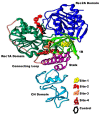Structure-Based Virtual Screening Identifies Multiple Stable Binding Sites at the RecA Domains of SARS-CoV-2 Helicase Enzyme
- PMID: 33800013
- PMCID: PMC7962107
- DOI: 10.3390/molecules26051446
Structure-Based Virtual Screening Identifies Multiple Stable Binding Sites at the RecA Domains of SARS-CoV-2 Helicase Enzyme
Abstract
With the emergence and global spread of the COVID-19 pandemic, the scientific community worldwide has focused on search for new therapeutic strategies against this disease. One such critical approach is targeting proteins such as helicases that regulate most of the SARS-CoV-2 RNA metabolism. The purpose of the current study was to predict a library of phytochemicals derived from diverse plant families with high binding affinity to SARS-CoV-2 helicase (Nsp13) enzyme. High throughput virtual screening of the Medicinal Plant Database for Drug Design (MPD3) database was performed on SARS-CoV-2 helicase using AutoDock Vina. Nilotinib, with a docking value of -9.6 kcal/mol, was chosen as a reference molecule. A compound (PubChem CID: 110143421, ZINC database ID: ZINC257223845, eMolecules: 43290531) was screened as the best binder (binding energy of -10.2 kcal/mol on average) to the enzyme by using repeated docking runs in the screening process. On inspection, the compound was disclosed to show different binding sites of the triangular pockets collectively formed by Rec1A, Rec2A, and 1B domains and a stalk domain at the base. The molecule is often bound to the ATP binding site (referred to as binding site 2) of the helicase enzyme. The compound was further discovered to fulfill drug-likeness and lead-likeness criteria, have good physicochemical and pharmacokinetics properties, and to be non-toxic. Molecular dynamic simulation analysis of the control/lead compound complexes demonstrated the formation of stable complexes with good intermolecular binding affinity. Lastly, affirmation of the docking simulation studies was accomplished by estimating the binding free energy by MMPB/GBSA technique. Taken together, these findings present further in silco investigation of plant-derived lead compounds to effectively address COVID-19.
Keywords: COVID-19; SARS-CoV-2 helicase; molecular dynamic simulation; phytochemicals.
Conflict of interest statement
The authors declare no conflict of interest.
Figures








Similar articles
-
Mapping major SARS-CoV-2 drug targets and assessment of druggability using computational fragment screening: Identification of an allosteric small-molecule binding site on the Nsp13 helicase.PLoS One. 2021 Feb 17;16(2):e0246181. doi: 10.1371/journal.pone.0246181. eCollection 2021. PLoS One. 2021. PMID: 33596235 Free PMC article.
-
A structural-based virtual screening and in vitro validation reveals novel effective inhibitors for SARS-CoV-2 helicase and endoribonuclease.J Biomol Struct Dyn. 2024 Oct;42(17):9145-9158. doi: 10.1080/07391102.2023.2250479. Epub 2023 Aug 24. J Biomol Struct Dyn. 2024. PMID: 37615430
-
Evaluation of the potency of FDA-approved drugs on wild type and mutant SARS-CoV-2 helicase (Nsp13).Int J Biol Macromol. 2020 Nov 15;163:1687-1696. doi: 10.1016/j.ijbiomac.2020.09.138. Epub 2020 Sep 24. Int J Biol Macromol. 2020. PMID: 32980406 Free PMC article.
-
Coronavirus helicases: attractive and unique targets of antiviral drug-development and therapeutic patents.Expert Opin Ther Pat. 2021 Apr;31(4):339-350. doi: 10.1080/13543776.2021.1884224. Epub 2021 Apr 21. Expert Opin Ther Pat. 2021. PMID: 33593200 Free PMC article. Review.
-
Computational Lock and Key and Dynamic Trajectory Analysis of Natural Biophors Against COVID-19 Spike Protein to Identify Effective Lead Molecules.Mol Biotechnol. 2021 Oct;63(10):898-908. doi: 10.1007/s12033-021-00358-z. Epub 2021 Jun 22. Mol Biotechnol. 2021. PMID: 34159564 Free PMC article. Review.
Cited by
-
Discovery of Potential Antiviral Compounds against Hendra Virus by Targeting Its Receptor-Binding Protein (G) Using Computational Approaches.Molecules. 2022 Jan 16;27(2):554. doi: 10.3390/molecules27020554. Molecules. 2022. PMID: 35056869 Free PMC article.
-
Variable Inhibition of DNA Unwinding Rates Catalyzed by the SARS-CoV-2 Helicase Nsp13 by Structurally Distinct Single DNA Lesions.Int J Mol Sci. 2024 Jul 19;25(14):7930. doi: 10.3390/ijms25147930. Int J Mol Sci. 2024. PMID: 39063172 Free PMC article.
-
Potential COVID-19 Therapies from Computational Repurposing of Drugs and Natural Products against the SARS-CoV-2 Helicase.Int J Mol Sci. 2022 Jul 12;23(14):7704. doi: 10.3390/ijms23147704. Int J Mol Sci. 2022. PMID: 35887049 Free PMC article.
-
RNA helicases required for viral propagation in humans.Enzymes. 2021;50:335-367. doi: 10.1016/bs.enz.2021.09.005. Epub 2021 Nov 2. Enzymes. 2021. PMID: 34861942 Free PMC article. Review.
-
Translating GWAS Findings to Inform Drug Repositioning Strategies for COVID-19 Treatment.Res Sq [Preprint]. 2023 Oct 19:rs.3.rs-3443080. doi: 10.21203/rs.3.rs-3443080/v1. Res Sq. 2023. PMID: 37886583 Free PMC article. Preprint.
References
MeSH terms
Substances
LinkOut - more resources
Full Text Sources
Other Literature Sources
Miscellaneous

